K-12 Curriculum Development and Implementation Report for Science
VerifiedAdded on 2022/09/12
|9
|1794
|26
Report
AI Summary
This report provides a comprehensive overview of curriculum development and implementation, specifically focusing on a K-12 science program. It outlines the rationale for the curriculum, which centers around improving students' reading skills, vocabulary, and overall comprehension in the field of science. The report details the core instructional goals, emphasizing the increase of knowledge, skills, and positive behaviors through curriculum activities. It explores different approaches to curriculum design, including the subject-centered approach, and discusses the influence of Bloom's Taxonomy on learning objectives. Strategies for critical thinking and the desired learning outcomes for students are presented, along with the integration of technology to enhance the learning experience. The report also highlights key elements of curriculum design and development, such as structuring concepts, learning activities, and student abilities, to ensure effective program implementation. The references provided support the concepts discussed throughout the report.
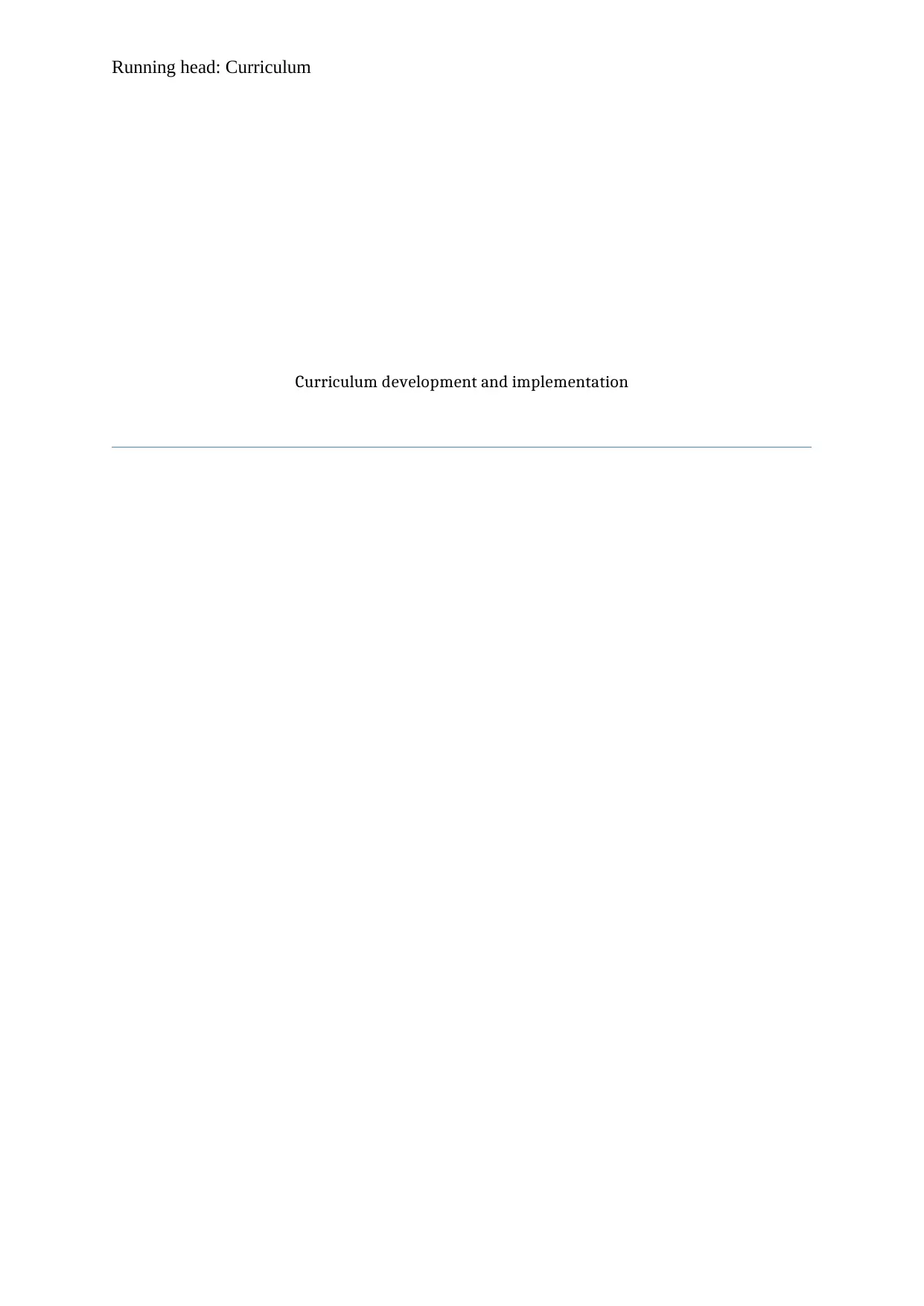
Running head: Curriculum
Curriculum development and implementation
Curriculum development and implementation
Paraphrase This Document
Need a fresh take? Get an instant paraphrase of this document with our AI Paraphraser
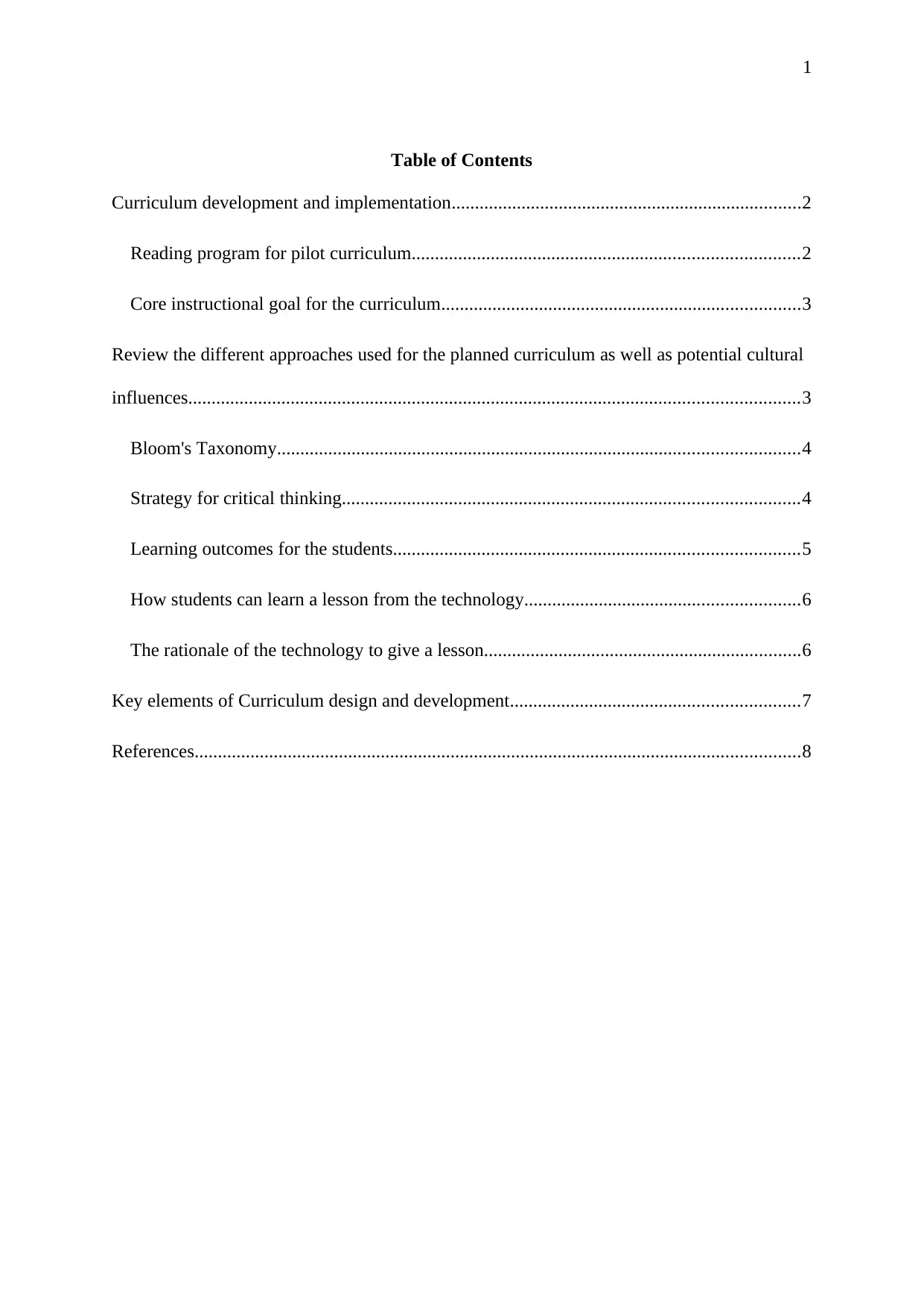
1
Table of Contents
Curriculum development and implementation...........................................................................2
Reading program for pilot curriculum...................................................................................2
Core instructional goal for the curriculum.............................................................................3
Review the different approaches used for the planned curriculum as well as potential cultural
influences...................................................................................................................................3
Bloom's Taxonomy................................................................................................................4
Strategy for critical thinking..................................................................................................4
Learning outcomes for the students.......................................................................................5
How students can learn a lesson from the technology...........................................................6
The rationale of the technology to give a lesson....................................................................6
Key elements of Curriculum design and development..............................................................7
References..................................................................................................................................8
Table of Contents
Curriculum development and implementation...........................................................................2
Reading program for pilot curriculum...................................................................................2
Core instructional goal for the curriculum.............................................................................3
Review the different approaches used for the planned curriculum as well as potential cultural
influences...................................................................................................................................3
Bloom's Taxonomy................................................................................................................4
Strategy for critical thinking..................................................................................................4
Learning outcomes for the students.......................................................................................5
How students can learn a lesson from the technology...........................................................6
The rationale of the technology to give a lesson....................................................................6
Key elements of Curriculum design and development..............................................................7
References..................................................................................................................................8
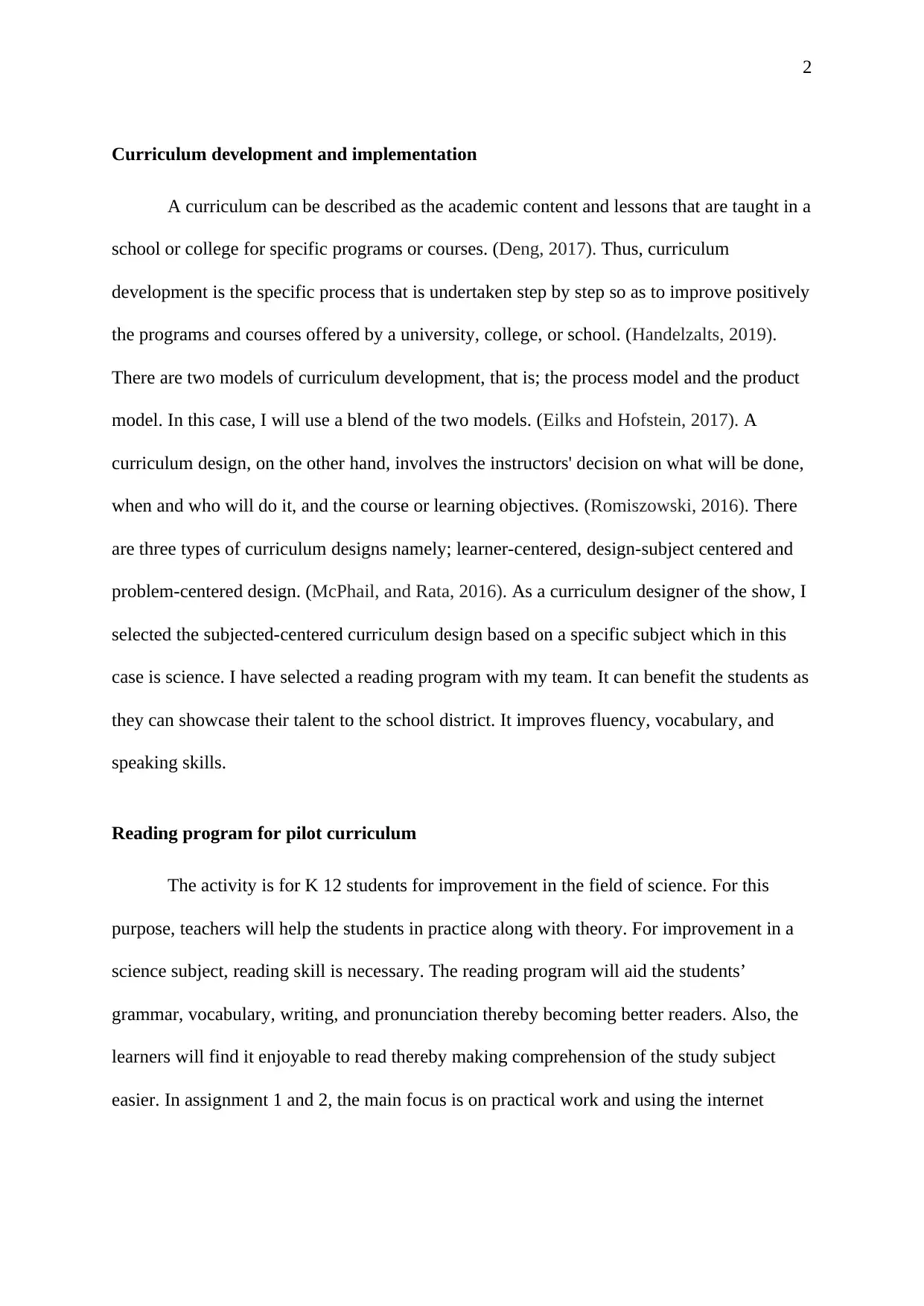
2
Curriculum development and implementation
A curriculum can be described as the academic content and lessons that are taught in a
school or college for specific programs or courses. (Deng, 2017). Thus, curriculum
development is the specific process that is undertaken step by step so as to improve positively
the programs and courses offered by a university, college, or school. (Handelzalts, 2019).
There are two models of curriculum development, that is; the process model and the product
model. In this case, I will use a blend of the two models. (Eilks and Hofstein, 2017). A
curriculum design, on the other hand, involves the instructors' decision on what will be done,
when and who will do it, and the course or learning objectives. (Romiszowski, 2016). There
are three types of curriculum designs namely; learner-centered, design-subject centered and
problem-centered design. (McPhail, and Rata, 2016). As a curriculum designer of the show, I
selected the subjected-centered curriculum design based on a specific subject which in this
case is science. I have selected a reading program with my team. It can benefit the students as
they can showcase their talent to the school district. It improves fluency, vocabulary, and
speaking skills.
Reading program for pilot curriculum
The activity is for K 12 students for improvement in the field of science. For this
purpose, teachers will help the students in practice along with theory. For improvement in a
science subject, reading skill is necessary. The reading program will aid the students’
grammar, vocabulary, writing, and pronunciation thereby becoming better readers. Also, the
learners will find it enjoyable to read thereby making comprehension of the study subject
easier. In assignment 1 and 2, the main focus is on practical work and using the internet
Curriculum development and implementation
A curriculum can be described as the academic content and lessons that are taught in a
school or college for specific programs or courses. (Deng, 2017). Thus, curriculum
development is the specific process that is undertaken step by step so as to improve positively
the programs and courses offered by a university, college, or school. (Handelzalts, 2019).
There are two models of curriculum development, that is; the process model and the product
model. In this case, I will use a blend of the two models. (Eilks and Hofstein, 2017). A
curriculum design, on the other hand, involves the instructors' decision on what will be done,
when and who will do it, and the course or learning objectives. (Romiszowski, 2016). There
are three types of curriculum designs namely; learner-centered, design-subject centered and
problem-centered design. (McPhail, and Rata, 2016). As a curriculum designer of the show, I
selected the subjected-centered curriculum design based on a specific subject which in this
case is science. I have selected a reading program with my team. It can benefit the students as
they can showcase their talent to the school district. It improves fluency, vocabulary, and
speaking skills.
Reading program for pilot curriculum
The activity is for K 12 students for improvement in the field of science. For this
purpose, teachers will help the students in practice along with theory. For improvement in a
science subject, reading skill is necessary. The reading program will aid the students’
grammar, vocabulary, writing, and pronunciation thereby becoming better readers. Also, the
learners will find it enjoyable to read thereby making comprehension of the study subject
easier. In assignment 1 and 2, the main focus is on practical work and using the internet
⊘ This is a preview!⊘
Do you want full access?
Subscribe today to unlock all pages.

Trusted by 1+ million students worldwide
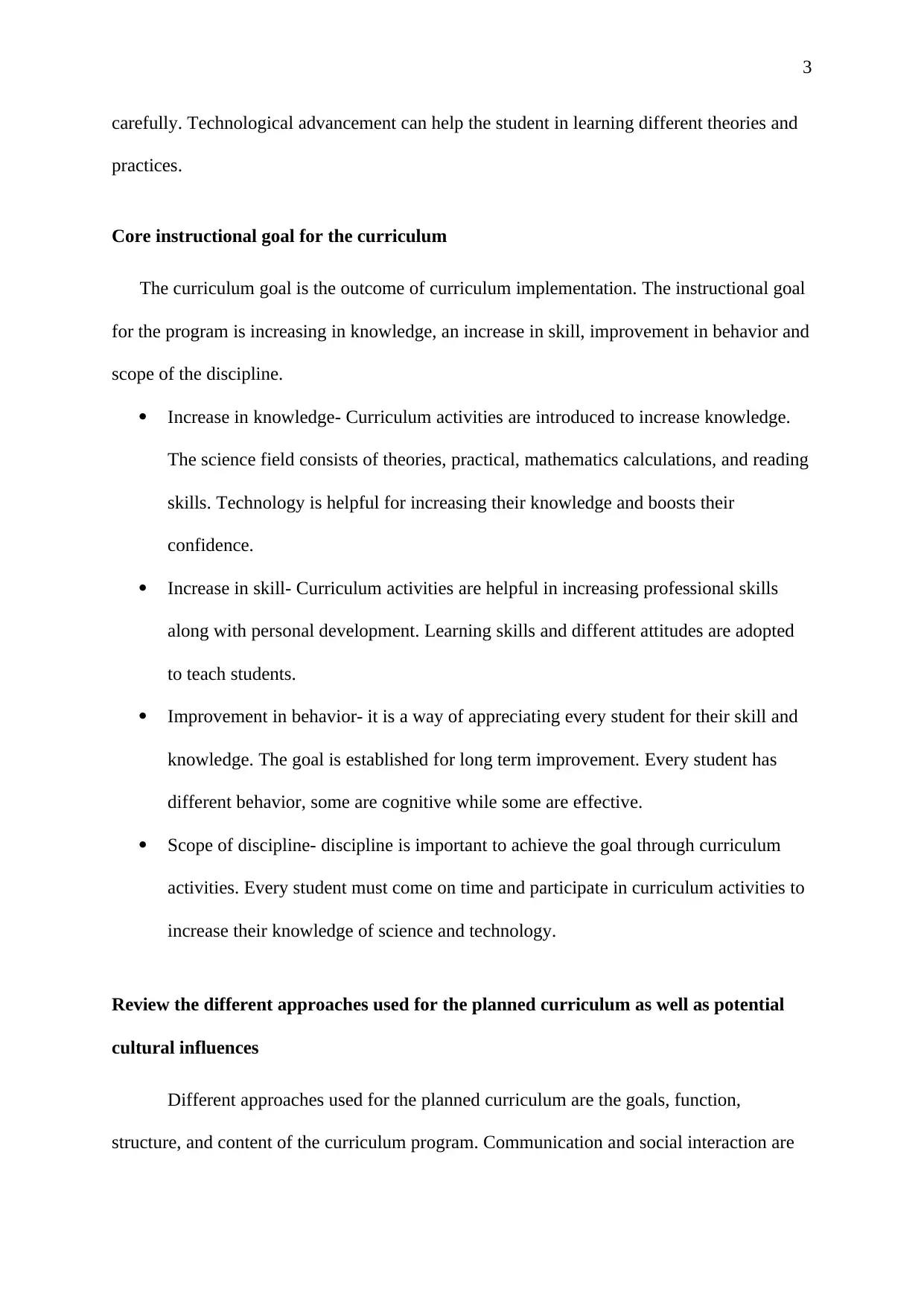
3
carefully. Technological advancement can help the student in learning different theories and
practices.
Core instructional goal for the curriculum
The curriculum goal is the outcome of curriculum implementation. The instructional goal
for the program is increasing in knowledge, an increase in skill, improvement in behavior and
scope of the discipline.
Increase in knowledge- Curriculum activities are introduced to increase knowledge.
The science field consists of theories, practical, mathematics calculations, and reading
skills. Technology is helpful for increasing their knowledge and boosts their
confidence.
Increase in skill- Curriculum activities are helpful in increasing professional skills
along with personal development. Learning skills and different attitudes are adopted
to teach students.
Improvement in behavior- it is a way of appreciating every student for their skill and
knowledge. The goal is established for long term improvement. Every student has
different behavior, some are cognitive while some are effective.
Scope of discipline- discipline is important to achieve the goal through curriculum
activities. Every student must come on time and participate in curriculum activities to
increase their knowledge of science and technology.
Review the different approaches used for the planned curriculum as well as potential
cultural influences
Different approaches used for the planned curriculum are the goals, function,
structure, and content of the curriculum program. Communication and social interaction are
carefully. Technological advancement can help the student in learning different theories and
practices.
Core instructional goal for the curriculum
The curriculum goal is the outcome of curriculum implementation. The instructional goal
for the program is increasing in knowledge, an increase in skill, improvement in behavior and
scope of the discipline.
Increase in knowledge- Curriculum activities are introduced to increase knowledge.
The science field consists of theories, practical, mathematics calculations, and reading
skills. Technology is helpful for increasing their knowledge and boosts their
confidence.
Increase in skill- Curriculum activities are helpful in increasing professional skills
along with personal development. Learning skills and different attitudes are adopted
to teach students.
Improvement in behavior- it is a way of appreciating every student for their skill and
knowledge. The goal is established for long term improvement. Every student has
different behavior, some are cognitive while some are effective.
Scope of discipline- discipline is important to achieve the goal through curriculum
activities. Every student must come on time and participate in curriculum activities to
increase their knowledge of science and technology.
Review the different approaches used for the planned curriculum as well as potential
cultural influences
Different approaches used for the planned curriculum are the goals, function,
structure, and content of the curriculum program. Communication and social interaction are
Paraphrase This Document
Need a fresh take? Get an instant paraphrase of this document with our AI Paraphraser
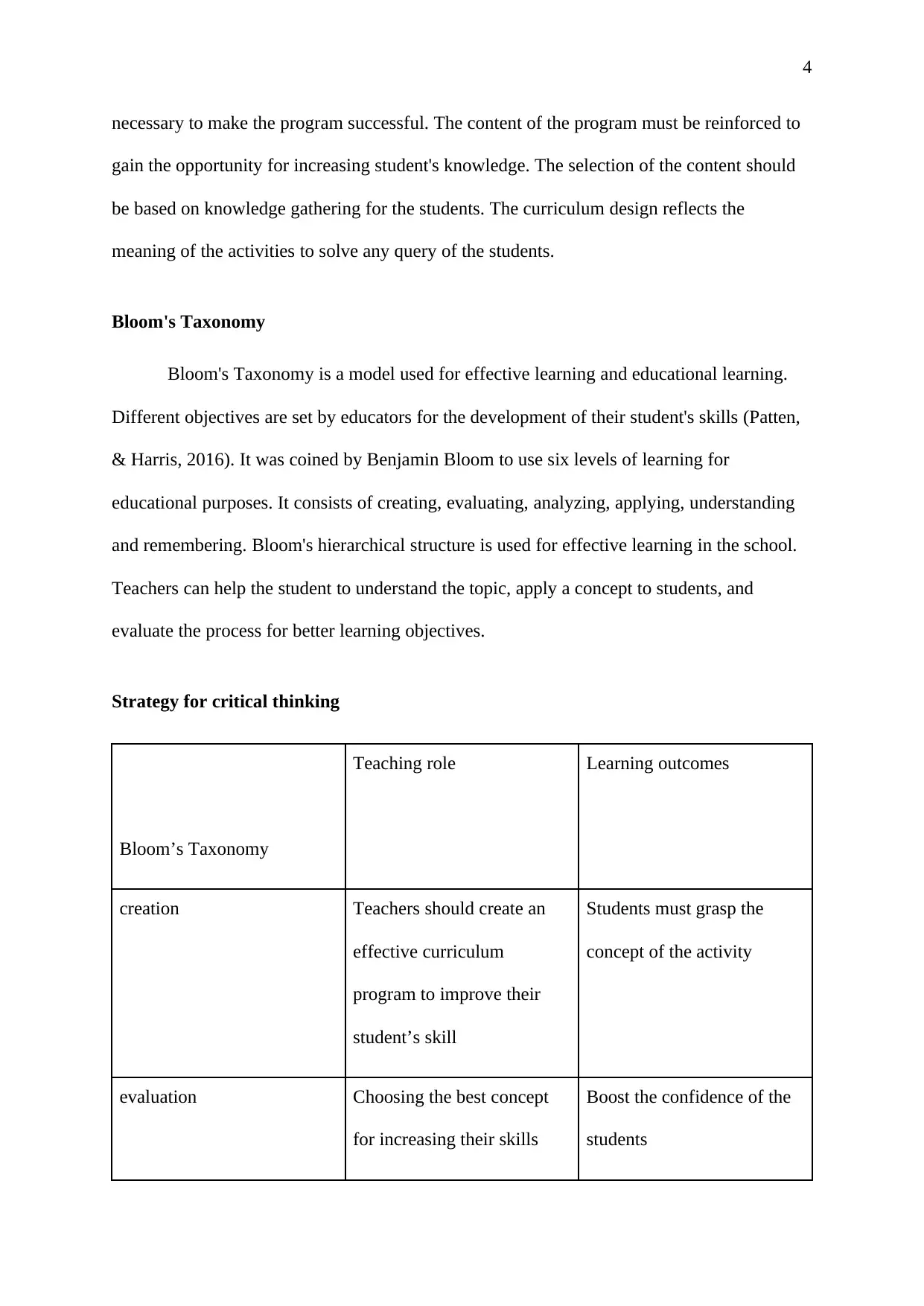
4
necessary to make the program successful. The content of the program must be reinforced to
gain the opportunity for increasing student's knowledge. The selection of the content should
be based on knowledge gathering for the students. The curriculum design reflects the
meaning of the activities to solve any query of the students.
Bloom's Taxonomy
Bloom's Taxonomy is a model used for effective learning and educational learning.
Different objectives are set by educators for the development of their student's skills (Patten,
& Harris, 2016). It was coined by Benjamin Bloom to use six levels of learning for
educational purposes. It consists of creating, evaluating, analyzing, applying, understanding
and remembering. Bloom's hierarchical structure is used for effective learning in the school.
Teachers can help the student to understand the topic, apply a concept to students, and
evaluate the process for better learning objectives.
Strategy for critical thinking
Bloom’s Taxonomy
Teaching role Learning outcomes
creation Teachers should create an
effective curriculum
program to improve their
student’s skill
Students must grasp the
concept of the activity
evaluation Choosing the best concept
for increasing their skills
Boost the confidence of the
students
necessary to make the program successful. The content of the program must be reinforced to
gain the opportunity for increasing student's knowledge. The selection of the content should
be based on knowledge gathering for the students. The curriculum design reflects the
meaning of the activities to solve any query of the students.
Bloom's Taxonomy
Bloom's Taxonomy is a model used for effective learning and educational learning.
Different objectives are set by educators for the development of their student's skills (Patten,
& Harris, 2016). It was coined by Benjamin Bloom to use six levels of learning for
educational purposes. It consists of creating, evaluating, analyzing, applying, understanding
and remembering. Bloom's hierarchical structure is used for effective learning in the school.
Teachers can help the student to understand the topic, apply a concept to students, and
evaluate the process for better learning objectives.
Strategy for critical thinking
Bloom’s Taxonomy
Teaching role Learning outcomes
creation Teachers should create an
effective curriculum
program to improve their
student’s skill
Students must grasp the
concept of the activity
evaluation Choosing the best concept
for increasing their skills
Boost the confidence of the
students
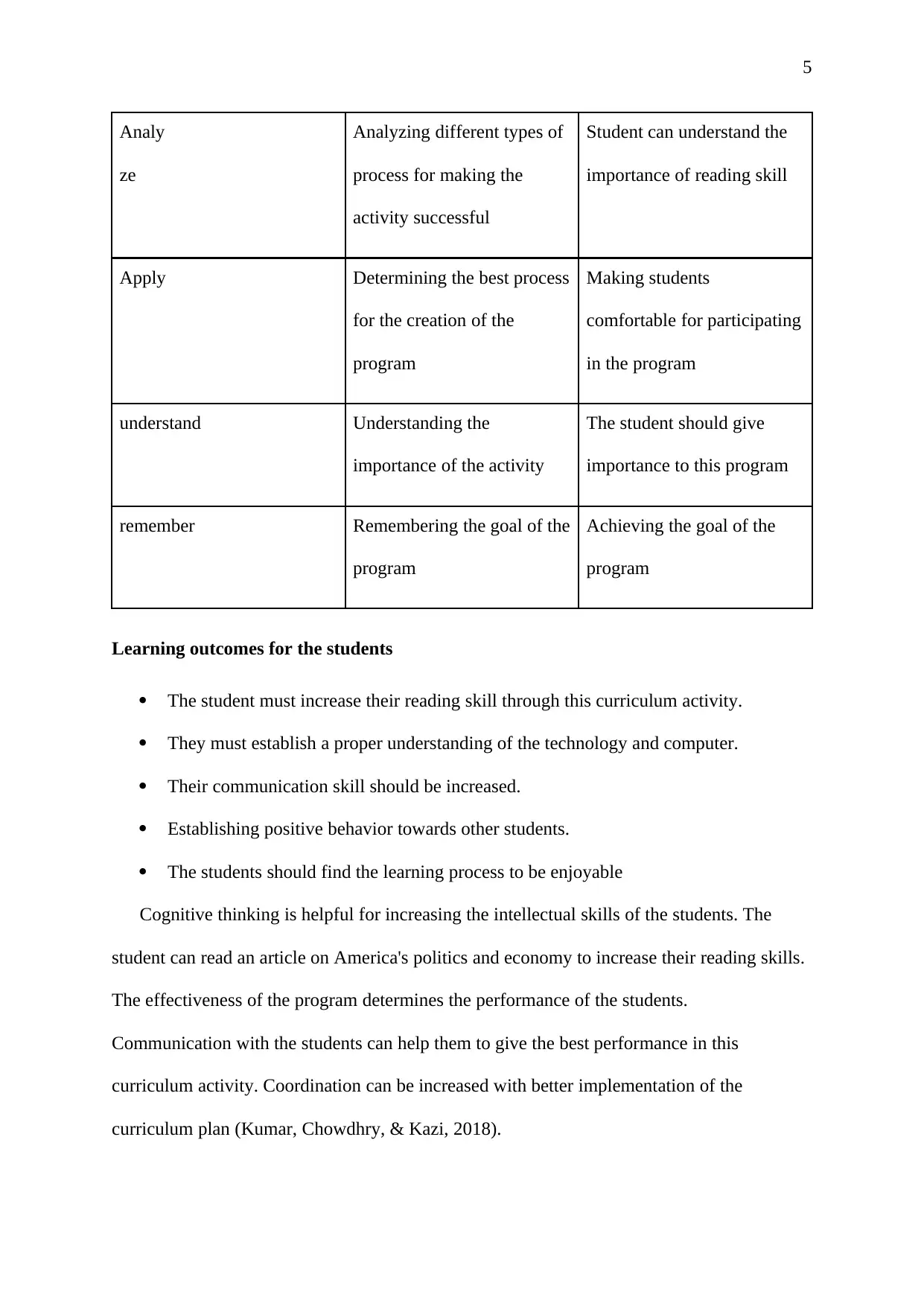
5
Analy
ze
Analyzing different types of
process for making the
activity successful
Student can understand the
importance of reading skill
Apply Determining the best process
for the creation of the
program
Making students
comfortable for participating
in the program
understand Understanding the
importance of the activity
The student should give
importance to this program
remember Remembering the goal of the
program
Achieving the goal of the
program
Learning outcomes for the students
The student must increase their reading skill through this curriculum activity.
They must establish a proper understanding of the technology and computer.
Their communication skill should be increased.
Establishing positive behavior towards other students.
The students should find the learning process to be enjoyable
Cognitive thinking is helpful for increasing the intellectual skills of the students. The
student can read an article on America's politics and economy to increase their reading skills.
The effectiveness of the program determines the performance of the students.
Communication with the students can help them to give the best performance in this
curriculum activity. Coordination can be increased with better implementation of the
curriculum plan (Kumar, Chowdhry, & Kazi, 2018).
Analy
ze
Analyzing different types of
process for making the
activity successful
Student can understand the
importance of reading skill
Apply Determining the best process
for the creation of the
program
Making students
comfortable for participating
in the program
understand Understanding the
importance of the activity
The student should give
importance to this program
remember Remembering the goal of the
program
Achieving the goal of the
program
Learning outcomes for the students
The student must increase their reading skill through this curriculum activity.
They must establish a proper understanding of the technology and computer.
Their communication skill should be increased.
Establishing positive behavior towards other students.
The students should find the learning process to be enjoyable
Cognitive thinking is helpful for increasing the intellectual skills of the students. The
student can read an article on America's politics and economy to increase their reading skills.
The effectiveness of the program determines the performance of the students.
Communication with the students can help them to give the best performance in this
curriculum activity. Coordination can be increased with better implementation of the
curriculum plan (Kumar, Chowdhry, & Kazi, 2018).
⊘ This is a preview!⊘
Do you want full access?
Subscribe today to unlock all pages.

Trusted by 1+ million students worldwide
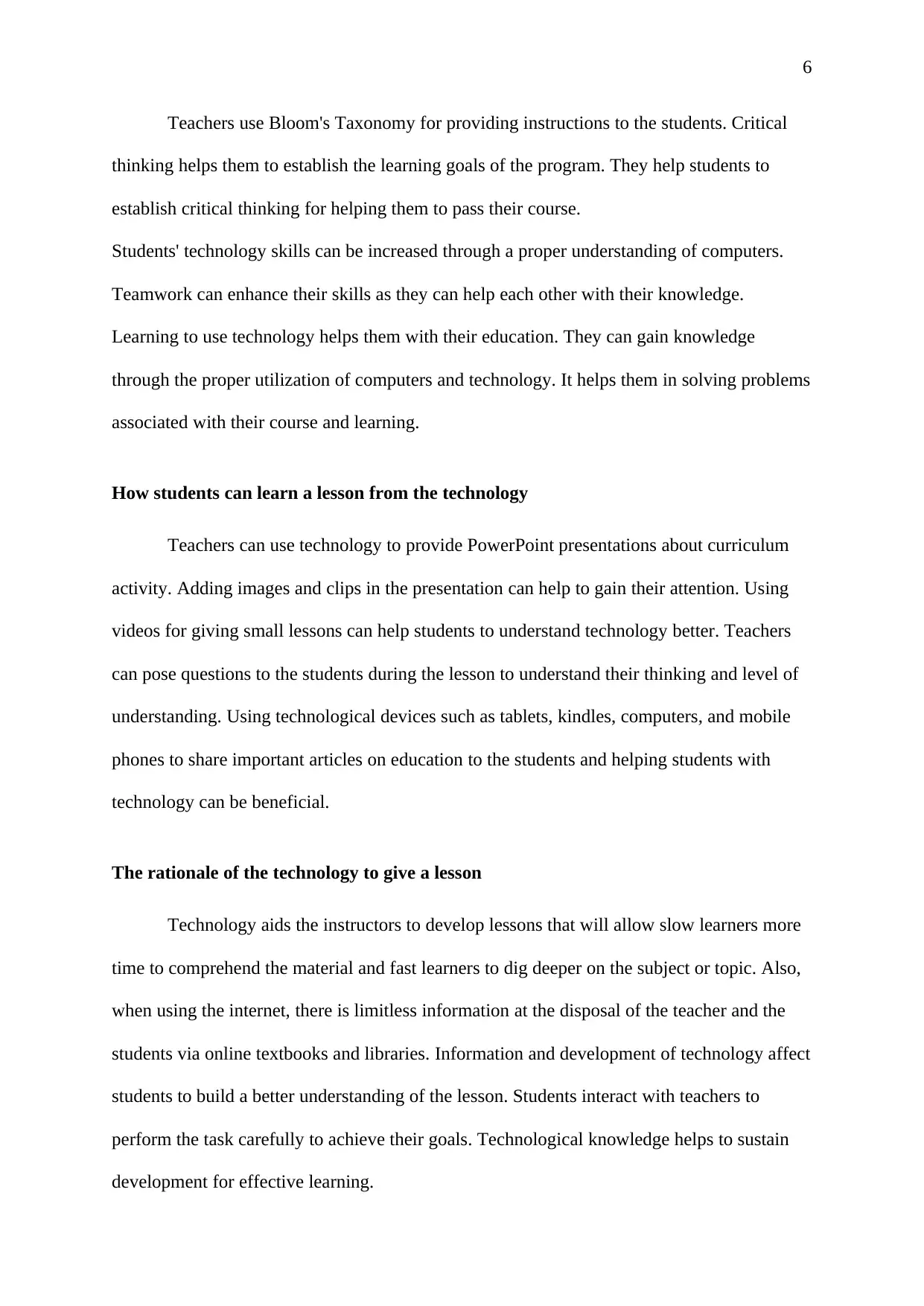
6
Teachers use Bloom's Taxonomy for providing instructions to the students. Critical
thinking helps them to establish the learning goals of the program. They help students to
establish critical thinking for helping them to pass their course.
Students' technology skills can be increased through a proper understanding of computers.
Teamwork can enhance their skills as they can help each other with their knowledge.
Learning to use technology helps them with their education. They can gain knowledge
through the proper utilization of computers and technology. It helps them in solving problems
associated with their course and learning.
How students can learn a lesson from the technology
Teachers can use technology to provide PowerPoint presentations about curriculum
activity. Adding images and clips in the presentation can help to gain their attention. Using
videos for giving small lessons can help students to understand technology better. Teachers
can pose questions to the students during the lesson to understand their thinking and level of
understanding. Using technological devices such as tablets, kindles, computers, and mobile
phones to share important articles on education to the students and helping students with
technology can be beneficial.
The rationale of the technology to give a lesson
Technology aids the instructors to develop lessons that will allow slow learners more
time to comprehend the material and fast learners to dig deeper on the subject or topic. Also,
when using the internet, there is limitless information at the disposal of the teacher and the
students via online textbooks and libraries. Information and development of technology affect
students to build a better understanding of the lesson. Students interact with teachers to
perform the task carefully to achieve their goals. Technological knowledge helps to sustain
development for effective learning.
Teachers use Bloom's Taxonomy for providing instructions to the students. Critical
thinking helps them to establish the learning goals of the program. They help students to
establish critical thinking for helping them to pass their course.
Students' technology skills can be increased through a proper understanding of computers.
Teamwork can enhance their skills as they can help each other with their knowledge.
Learning to use technology helps them with their education. They can gain knowledge
through the proper utilization of computers and technology. It helps them in solving problems
associated with their course and learning.
How students can learn a lesson from the technology
Teachers can use technology to provide PowerPoint presentations about curriculum
activity. Adding images and clips in the presentation can help to gain their attention. Using
videos for giving small lessons can help students to understand technology better. Teachers
can pose questions to the students during the lesson to understand their thinking and level of
understanding. Using technological devices such as tablets, kindles, computers, and mobile
phones to share important articles on education to the students and helping students with
technology can be beneficial.
The rationale of the technology to give a lesson
Technology aids the instructors to develop lessons that will allow slow learners more
time to comprehend the material and fast learners to dig deeper on the subject or topic. Also,
when using the internet, there is limitless information at the disposal of the teacher and the
students via online textbooks and libraries. Information and development of technology affect
students to build a better understanding of the lesson. Students interact with teachers to
perform the task carefully to achieve their goals. Technological knowledge helps to sustain
development for effective learning.
Paraphrase This Document
Need a fresh take? Get an instant paraphrase of this document with our AI Paraphraser
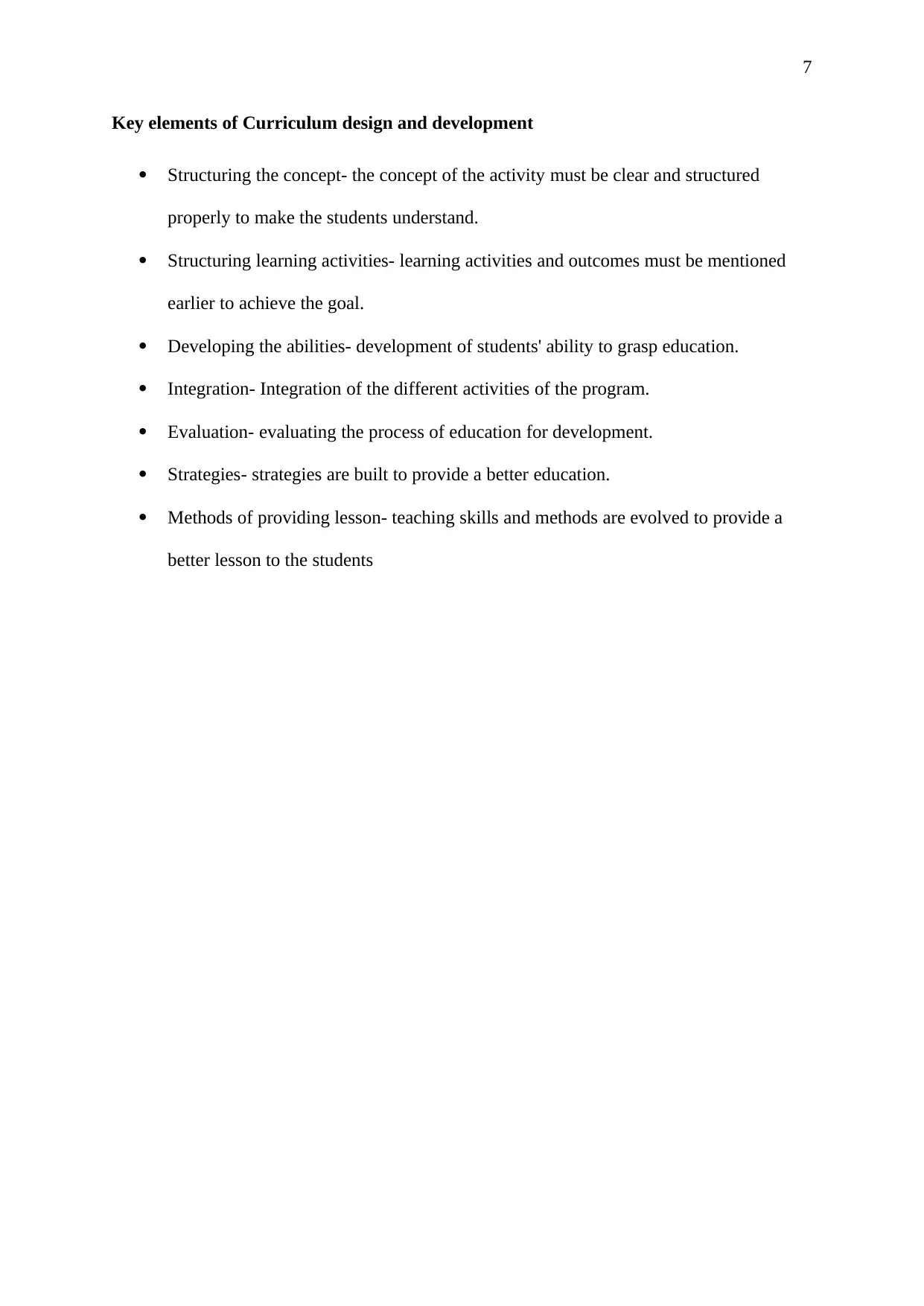
7
Key elements of Curriculum design and development
Structuring the concept- the concept of the activity must be clear and structured
properly to make the students understand.
Structuring learning activities- learning activities and outcomes must be mentioned
earlier to achieve the goal.
Developing the abilities- development of students' ability to grasp education.
Integration- Integration of the different activities of the program.
Evaluation- evaluating the process of education for development.
Strategies- strategies are built to provide a better education.
Methods of providing lesson- teaching skills and methods are evolved to provide a
better lesson to the students
Key elements of Curriculum design and development
Structuring the concept- the concept of the activity must be clear and structured
properly to make the students understand.
Structuring learning activities- learning activities and outcomes must be mentioned
earlier to achieve the goal.
Developing the abilities- development of students' ability to grasp education.
Integration- Integration of the different activities of the program.
Evaluation- evaluating the process of education for development.
Strategies- strategies are built to provide a better education.
Methods of providing lesson- teaching skills and methods are evolved to provide a
better lesson to the students
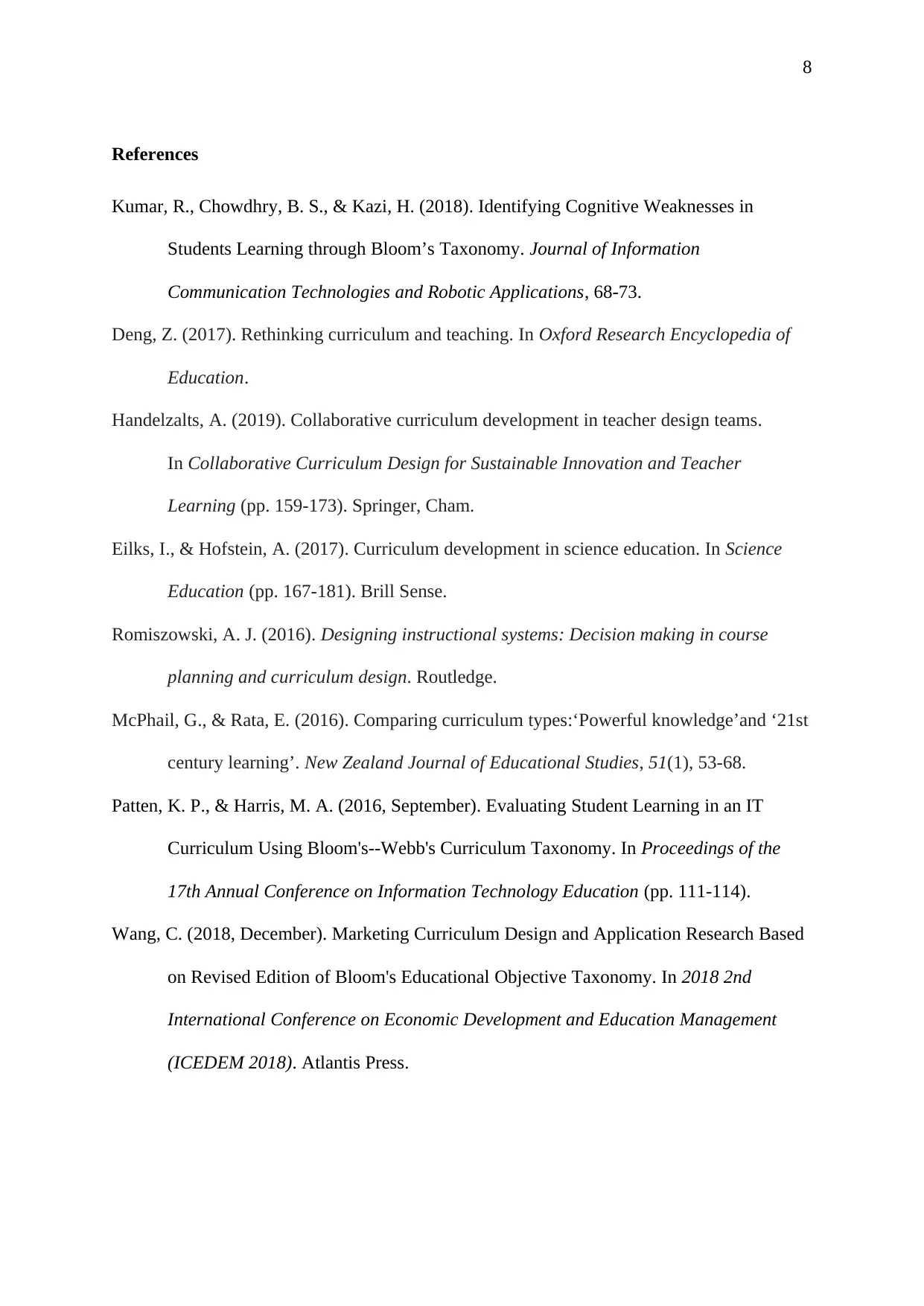
8
References
Kumar, R., Chowdhry, B. S., & Kazi, H. (2018). Identifying Cognitive Weaknesses in
Students Learning through Bloom’s Taxonomy. Journal of Information
Communication Technologies and Robotic Applications, 68-73.
Deng, Z. (2017). Rethinking curriculum and teaching. In Oxford Research Encyclopedia of
Education.
Handelzalts, A. (2019). Collaborative curriculum development in teacher design teams.
In Collaborative Curriculum Design for Sustainable Innovation and Teacher
Learning (pp. 159-173). Springer, Cham.
Eilks, I., & Hofstein, A. (2017). Curriculum development in science education. In Science
Education (pp. 167-181). Brill Sense.
Romiszowski, A. J. (2016). Designing instructional systems: Decision making in course
planning and curriculum design. Routledge.
McPhail, G., & Rata, E. (2016). Comparing curriculum types:‘Powerful knowledge’and ‘21st
century learning’. New Zealand Journal of Educational Studies, 51(1), 53-68.
Patten, K. P., & Harris, M. A. (2016, September). Evaluating Student Learning in an IT
Curriculum Using Bloom's--Webb's Curriculum Taxonomy. In Proceedings of the
17th Annual Conference on Information Technology Education (pp. 111-114).
Wang, C. (2018, December). Marketing Curriculum Design and Application Research Based
on Revised Edition of Bloom's Educational Objective Taxonomy. In 2018 2nd
International Conference on Economic Development and Education Management
(ICEDEM 2018). Atlantis Press.
References
Kumar, R., Chowdhry, B. S., & Kazi, H. (2018). Identifying Cognitive Weaknesses in
Students Learning through Bloom’s Taxonomy. Journal of Information
Communication Technologies and Robotic Applications, 68-73.
Deng, Z. (2017). Rethinking curriculum and teaching. In Oxford Research Encyclopedia of
Education.
Handelzalts, A. (2019). Collaborative curriculum development in teacher design teams.
In Collaborative Curriculum Design for Sustainable Innovation and Teacher
Learning (pp. 159-173). Springer, Cham.
Eilks, I., & Hofstein, A. (2017). Curriculum development in science education. In Science
Education (pp. 167-181). Brill Sense.
Romiszowski, A. J. (2016). Designing instructional systems: Decision making in course
planning and curriculum design. Routledge.
McPhail, G., & Rata, E. (2016). Comparing curriculum types:‘Powerful knowledge’and ‘21st
century learning’. New Zealand Journal of Educational Studies, 51(1), 53-68.
Patten, K. P., & Harris, M. A. (2016, September). Evaluating Student Learning in an IT
Curriculum Using Bloom's--Webb's Curriculum Taxonomy. In Proceedings of the
17th Annual Conference on Information Technology Education (pp. 111-114).
Wang, C. (2018, December). Marketing Curriculum Design and Application Research Based
on Revised Edition of Bloom's Educational Objective Taxonomy. In 2018 2nd
International Conference on Economic Development and Education Management
(ICEDEM 2018). Atlantis Press.
⊘ This is a preview!⊘
Do you want full access?
Subscribe today to unlock all pages.

Trusted by 1+ million students worldwide
1 out of 9
Related Documents
Your All-in-One AI-Powered Toolkit for Academic Success.
+13062052269
info@desklib.com
Available 24*7 on WhatsApp / Email
![[object Object]](/_next/static/media/star-bottom.7253800d.svg)
Unlock your academic potential
Copyright © 2020–2025 A2Z Services. All Rights Reserved. Developed and managed by ZUCOL.




